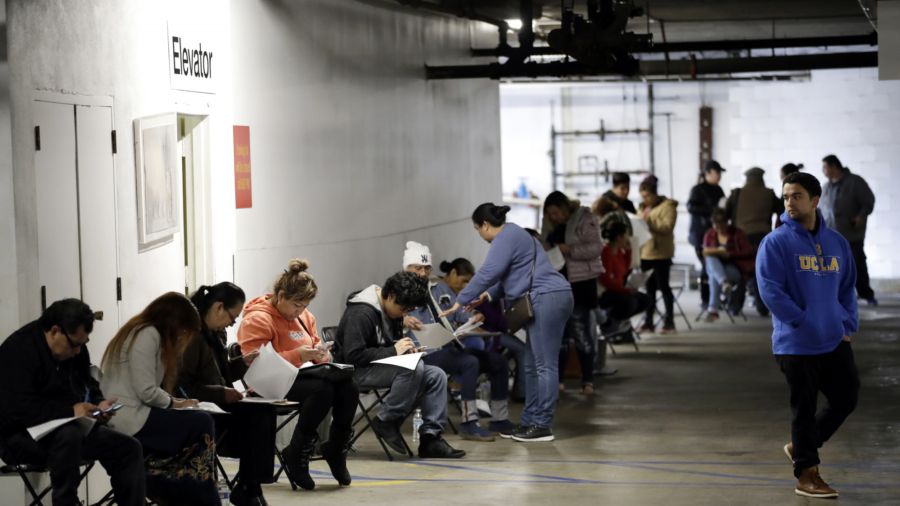More than 5 million workers in the United States filed unemployment claims during the week ending April 11, bringing the seasonally adjusted insured unemployment rate to a record high of 8.2 percent, Labor Department figures show.
The data released on April 16 (pdf) shows that the number of people filing initial jobless claims for the week ending April 11 was 5,245,000, while the unemployment rate surged by 3.1 percent from the previous week’s rate.
“This marks the highest level of the seasonally adjusted insured unemployment rate in the history of the seasonally adjusted series. The previous high was 7.0 percent in May of 1975,” the Labor Department said, also noting that “the COVID-19 virus continues to impact the number of initial claims and insured unemployment.”
The previous week’s initial jobless claims number was revised up by 9,000 from 6,606,000 to 6,615,000.
While the newly announced 5.3 million jobless claims number is lower than the record-setting 6.9 million claims filed during the week ending March 29, it brings the total unemployment claims filed in the past month to an astounding 20 million.
“Including this week, we currently project an additional 20 million in initial jobless claims through the end of May, after which we expect new claims to fall to levels consistent with prior recessions,” said Joseph Briggs, an economist at Goldman Sachs in New York.

The report followed dismal data on Wednesday showing a record drop in retail sales in March and the biggest decline in factory output since 1946.
Roughly 95 percent of the U.S. population is now under stay-at-home orders, and many factories, restaurants, stores, and other businesses are closed or have seen sales shrivel.
“My anxiety is through the roof right now, not knowing what’s going to happen,” said Laura Wieder, who was laid off from her job managing a now-closed sports bar in Bellefontaine, Ohio.
The mounting economic fallout almost certainly signals the onset of a global recession, with job losses that are likely to dwarf those of the Great Recession more than a decade ago.
Speaking at a virtual question and answer session on April 15, International Monetary Fund head Kristalina Georgieva said that the outbreak “is a crisis like no other” and that it has sparked the worst global recession since the Great Depression.

Still, in her remarks, the IMF head struck a hopeful note, insisting the crisis will eventually pass and urging governments to adjust policies to give economies the best chance for a quick bounce back.
She also called for more fiscal stimulus to help workers weather the storm caused by the CCP (Chinese Communist Party) virus, commonly known as the novel coronavirus, which causes the COVID-19 disease.
Among moves to help distressed workers, the $2.2 trillion emergency relief bill signed into law by President Donald Trump on March 27 gives states more flexibility to extend unemployment compensation.
The Coronavirus Aid, Relief, and Economic Security (CARES) Act expands states’ ability to provide unemployment insurance for many workers impacted by the COVID-19 pandemic, including for workers who aren’t ordinarily eligible for unemployment benefits, such as independent contractors.
Still, many economists believe there is still more downside for the labor market.
“Despite the numerous economic stimulus packages and signs of stabilization from the COVID-19 crisis, it is still too early for investors to relax,” said Milan Cutkovic, market analyst at AxiCorp.
Economists polled by Reuters expected weekly jobless claims to top 5 million for the week ending April 11, with some estimates going as high as 8 million.
“Expectations for economic data and the current earnings season are already extremely low (but) these figures could act as a reminder that the global economy is facing a deep recession and that recovery might take longer than initially expected,” Cutkovic added.
Reuters contributed to this report.
From The Epoch Times


